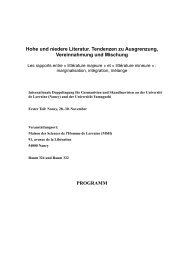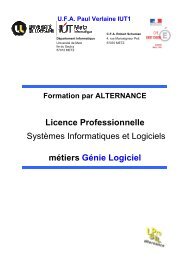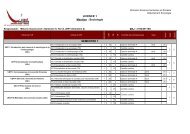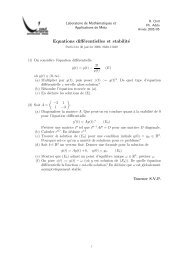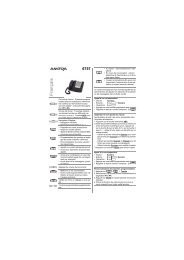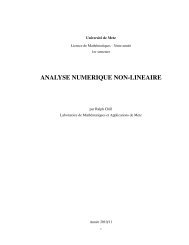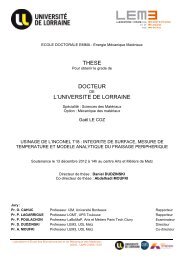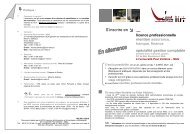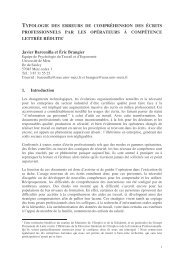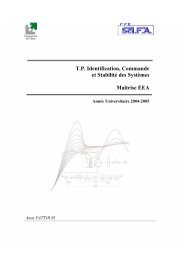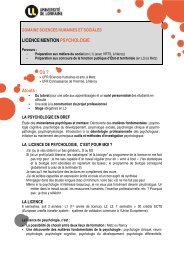Introductory Lecture
Introductory Lecture
Introductory Lecture
You also want an ePaper? Increase the reach of your titles
YUMPU automatically turns print PDFs into web optimized ePapers that Google loves.
MEETING ALAIN<br />
VILMOS KOMORNIK<br />
It is a great privilege for me to say a few words about Alain at the<br />
beginning of this special meeting. I would have never imagined such<br />
a possibility when I first met him in November 1982 at the lectures of<br />
Jacques-Louis Lions at the Collège de France, just some days after my<br />
first arrival to France. We were both interested in understanding the<br />
recent solution by Bensoussan of an optimal control problem of Lions.<br />
His openness and simplicity helped me a lot in filling many gaps in my<br />
knowledge of partial differential equations during my stay.<br />
One year later I met him again at a conference in Prague. Our<br />
research collaboration started there and was performed by exchanging<br />
many letters in that pre-internet era. His intriguing questions about<br />
the pointwise oscillation of the solutions of the wave equation led us<br />
to surprising paradoxical results. His approach seemed to me more<br />
Hungarian than French. He was very curious, he raised simple and<br />
natural questions which resisted the classical general methods. New<br />
ideas had to be found, and then they led to numerous applications in<br />
solving other, sometimes seemingly unrelated problems. This way of<br />
working was characteristic of Fejér, Pólya, Turán and Erdős.<br />
Our correspondance continued for years. Alain probably does not<br />
know that his letters meant for me almost the only connection with<br />
active mathematics during a whole year that I spent in a remote part<br />
of Venezuela in 1985–86. And that his arrangement to invite me to<br />
Paris for three months at the end of 1986 was crucial for me to resume<br />
my research. Incidentally, I happened to return to Paris just during<br />
the now historic lectures of Jacques-Louis Lions on exact controllability,<br />
and these lectures influenced my subsequent research for many years.<br />
Let me mention some more examples where his ideas greatly stimulated<br />
my own work. In two preprints in 1978, he introduced strangely<br />
looking new integral inequalities, similar to Gronwall’s lemma but with<br />
a reverse sign. It turned out ten years later that they provide sharp decay<br />
rate estimates for a large class of dissipative evolutionary problems;<br />
they are simpler and more efficient than the usual Liapunov function<br />
method. By the way, many papers on boundary stabilization were influenced<br />
by his joint work with Zuazua on the Liapunov method for<br />
internal stabilization. These results still stimulate much research: most<br />
recently Alabau–Boussouira proved a very useful extension of his integral<br />
inequalities.<br />
Date: March 23rd, 2009.<br />
1
2 VILMOS KOMORNIK<br />
In another work he needed a constructive proof of an Ingham–Parseval<br />
type result of Ball and Slemrod. He accomplished this by a clever<br />
and original argument. Hhis elementary lemma proved to be of great<br />
importance in the determination of the critical time of exact controllability:<br />
in a large number of situations it allowed one to eliminate<br />
elaborate and very technical arguments based on microlocal analysis,<br />
Carleman estimates or Holmgren type uniqueness theorems. In collaboration<br />
with Baiocchi and Loreti we have used many times Haraux’s<br />
method for various systems.<br />
Completing the important results of Lasiecka–Triggiani, Ho and Lions<br />
on the exact controllability of the wave equation, Bardos, Lebeau<br />
and Rauch essentially characterized the control domains by their socalled<br />
geometric control condition related to reflected rays. Alain made<br />
two important contributions to this domain. First, he proved that by<br />
applying very singular controls this condition is not any more necessary.<br />
Secondly, he proved by ingeniously simple Ingham type arguments that<br />
the geometric control condition is not necessary for rectangular plates,<br />
refuting a conjecture that the control domains are the same for membranes<br />
and plates. His result was improved by Jaffard, and these results<br />
stimulated much research in clarifying the role of singularities for this<br />
type of phenomenon.<br />
Looking at the list of publications of Alain Haraux, we realize in how<br />
many different fields he has worked. I can only mention a few results<br />
here.<br />
• He started his research in collaboration with Brezis on maximal<br />
monotone operators.<br />
• He obtained, partly in collaboration with Biroli and Otani,<br />
many interesting results on periodic or quasi-periodic solutions<br />
to parabolic or hyperbolic problems.<br />
• He established global existence and uniqueness results for nonlinear<br />
Schrödinger equations in collaboration with Cazenave,<br />
and non-uniqueness theorems for nonlinear parabolic equations<br />
in collaboration with Weissler.<br />
• Simultaneously with Hale and Ladyzenskaya, he discovered an<br />
important property of attractors of dynamical systems.<br />
• He studied the global behavior of solutions to various complex<br />
nonlinear hyperbolic, parabolic and finite-dimensional systems<br />
without monotonicity but having some dissipativity.<br />
• In collaboration with Jendoubi they succeeded in adapting a<br />
powerful method of Lojasiewicz and Simon to prove the asymptotic<br />
stability for some dissipative hyperbolic systems. In<br />
one of their papers they discovered a hidden connection among<br />
the approaches of Lojasiewicz–Simon, Aulbach, Zelenyak and<br />
Hale–Raugel. With Jendoubi and Kavian he also estimated the<br />
decay rate of semilinear parabolic systems by this method.
MEETING ALAIN 3<br />
I am apologizing for not having enough time to name all of his more<br />
than thirty collaborators, but I am sure that most of the important<br />
works will be covered during this conference. This will not be easy because<br />
his publications contain a multitude of original observations and<br />
ideas. His innocently-looking questions often led to elaborate theories<br />
and to many other questions, so that instead of clearing out a particular<br />
research field, his works opened up new directions with promising<br />
problems. This is why he had and has so many students and collaborators.<br />
In the last ten years our encounters become more sporadic: e-mail<br />
and telephone became cheaper than the train tickets and the hotels in<br />
Paris. We still had some nice meetings. Once, returning from Oberwolfach,<br />
he had to change the train in Strasbourg. He hesitated to call<br />
me to meet because he only had one hour to stay. Luckily, I arrived<br />
to the railway station just at that moment with Claudio Baiocchi who<br />
was about to return to Rome from Strasbourg. We had a very nice<br />
conversation all together.<br />
I would like end with two further comments on Alain’s working style.<br />
As I told, his openness and simplicity make it easy for young researchers<br />
to discuss with him. But at the same time, he maintains a<br />
high scientific rigor. His students have to work hard in order to get<br />
recognition. But those who succeed become independent, good and<br />
passionate researchers.<br />
By reading his papers, his books or by listening to his informal explanations<br />
or official talks, I was often struck by the clarity and simplicity<br />
of his expositions. I hope that this conference will reinforce his scientific<br />
influence and that numerous present and future colleagues will<br />
profit of his help, insight and teaching for many years to come.<br />
University of Strasbourg



